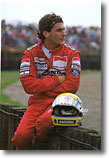|
McLaren-Honda
MP4/8 1993
Ayrton
Senna's Formula One career witnessed a meteoric rise
to prominence, first with Team Lotus in the early 1980s
and then with Team McLaren from 1988-93,  where
he waged several close battles with Alain
Prost. Senna won the Monaco Grand Prix a record
six times and was clearly the best qualifying F1 driver
of all time, with 65 pole positions (although second
on a percentage basis to Jim Clark).
His uncompromising driving style led to extreme reactions
among F1 aficionados — either adulation or hatred
— but his skill and bravery were unmatched. where
he waged several close battles with Alain
Prost. Senna won the Monaco Grand Prix a record
six times and was clearly the best qualifying F1 driver
of all time, with 65 pole positions (although second
on a percentage basis to Jim Clark).
His uncompromising driving style led to extreme reactions
among F1 aficionados — either adulation or hatred
— but his skill and bravery were unmatched.
In
1991, driving a plainly inferior McLaren-Honda MP4/6,
Senna amazingly recorded four pole positions and four
wins in the first four races. No one had ever started
a Formula One World Championship campaign with four
straight victories, and for the rest it was more than
demoralizing. With an increase in the points for a win
from 9 to 10 (and all races counting for the championship
for the first time in F1) Senna had 40 points, his nearest
challenger 11, and Nigel Mansell
of Williams just six. After holding off Mansell's late-season
charge, 1991 was to be Senna's third and last World
Championship, but by no means the end of his influence
in Formula One.
In
1993 Senna put on another spectacular show, once again
in an outmatched McLaren MP 4/8, to win five GPs. The
most impressive of these, and perhaps the finest victory
of his career, was at the European GP at Donnington
Park, where Senna won after picking up five places in
the rain on the first lap, cementing his place in history
as the rainmeister. And so, with a final victory
at Adelaide in the last race of the 1993 season, Ayrton
Senna prepared to move on to Team Williams, at long
last striking a $20 million per-year deal with the team,
and owner, who had given him his first test ride in
an F1 car more than a decade before. But as all F1 enthusiasts
know all too well, that was not to be. With new rules
declaring the "active cars" unlawful, Senna
did not post a single point for Williams — despite
three consecutive poles — in 1994.
In
the last years of his life, Senna seemed to mellow a
bit, becoming almost philosophical about the relationship
between Grand Prix racing and personal growth. Many
who had despised him when he was younger had, with the
passage of time, come to understand that Senna's brilliance
as a driver was matched by a depth of character and
compassion uncommon among the elite of F1. Senna's last
race was the 1994 San Marino GP, where he crashed and
died — after taking his final pole — while
leading the race on lap seven. Senna's untimely death
(one of only two in F1 since the late 1970s) left Formula
One without its shining star and ushered in a renewed
concern for safety. A highly religious man, Senna ironically
had a premonition on the evening before the race that
he would die. This painting is based on his final win
at the Australian GP in 1993.

| Ayrton
Senna's Career Profile |
| Seasons |
Races |
Wins |
Poles |
Fastest
Laps |
Points |
F1 Titles |
| 11 |
161 |
41 |
65 |
19 |
614 |
3 |
|






